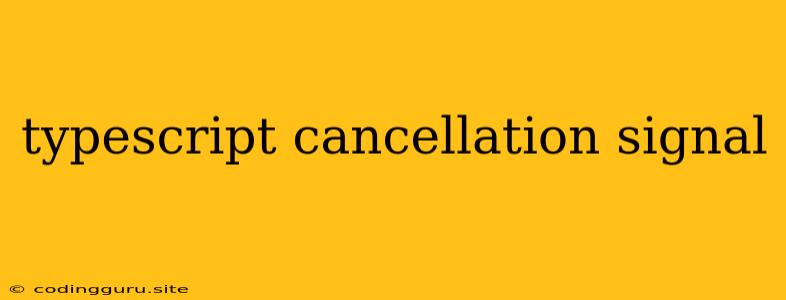Understanding and Utilizing Cancellation Signals in TypeScript
In the world of asynchronous programming, managing long-running operations and responding to user interactions effectively is crucial. This is where cancellation signals come into play. They offer a powerful mechanism to gracefully halt ongoing tasks when needed, preventing resource leaks and ensuring a smooth user experience. This article delves into the concept of cancellation signals in TypeScript, exploring their importance, implementation strategies, and best practices.
What are Cancellation Signals?
Imagine a scenario where you're fetching data from a remote server. The user initiates the request, but before the data arrives, they might decide to cancel the operation. This is where cancellation signals become essential. They act as a communication channel between your code and the asynchronous operations it initiates, allowing you to signal that the task should be aborted.
Why are Cancellation Signals Important in TypeScript?
Cancellation signals are fundamental for several reasons:
- Preventing Resource Leaks: Long-running tasks that are left running unnecessarily can consume valuable system resources, leading to performance issues and potentially crashing your application. Cancellation signals help you reclaim these resources by stopping the operations.
- Responsiveness: Users expect immediate feedback and control over their interactions. Cancellation signals enable you to respond quickly to user actions, such as cancelling a download or interrupting a complex computation.
- Error Handling: In case of errors, cancellation signals provide a structured way to handle the situation gracefully. Instead of letting the operation continue indefinitely, you can abort it and take appropriate actions.
- Improved Code Maintainability: By using cancellation signals, you can separate the logic for performing the task from the logic for cancelling it, resulting in cleaner and more modular code.
Implementing Cancellation Signals in TypeScript
TypeScript offers several ways to implement cancellation signals. Here are a few popular approaches:
1. The AbortController API:
The AbortController API, introduced in modern web browsers, is a built-in mechanism for managing cancellation.
Example:
const controller = new AbortController();
const signal = controller.signal;
fetch('https://api.example.com/data', { signal })
.then(response => {
// Handle the response
})
.catch(error => {
// Handle errors, including cancellation
});
// To cancel the request:
controller.abort();
This example demonstrates how to use the AbortController to create a signal and pass it to a fetch request. Calling controller.abort() triggers the cancellation.
2. Custom Cancellation Tokens:
You can create your own custom cancellation tokens to manage cancellation within your application. This is useful when dealing with asynchronous operations that don't directly support the AbortController API.
Example:
type CancellationToken = {
isCancelled: boolean;
cancel: () => void;
};
const createCancellationToken = (): CancellationToken => {
let isCancelled = false;
return {
isCancelled,
cancel: () => { isCancelled = true; },
};
};
const token = createCancellationToken();
// Simulate a long-running task
const longRunningTask = (token: CancellationToken) => {
for (let i = 0; i < 1000000; i++) {
if (token.isCancelled) {
console.log('Task cancelled!');
return;
}
// Perform some work here
}
console.log('Task completed!');
};
longRunningTask(token);
// Cancel the task after 5 seconds
setTimeout(() => {
token.cancel();
}, 5000);
This example defines a custom cancellation token with an isCancelled flag and a cancel function. It demonstrates how to use this token within a long-running task and how to cancel it.
3. Promises with Cancellation:
You can incorporate cancellation into promise-based operations. One way is to create a function that resolves a promise when cancelled.
Example:
function createCancelablePromise(
executor: (resolve: (value: T) => void, reject: (reason?: any) => void, cancel: () => void) => void
): Promise {
let cancel: () => void;
const promise = new Promise((resolve, reject) => {
executor(resolve, reject, cancel);
cancel = () => reject(new Error('Promise cancelled'));
});
return promise;
}
// Example usage
createCancelablePromise((resolve, reject, cancel) => {
// Long-running task
setTimeout(() => {
resolve('Task completed!');
}, 5000);
cancel = () => {
console.log('Task cancelled!');
};
}).catch(error => {
if (error.message === 'Promise cancelled') {
console.log('Promise cancelled!');
} else {
// Handle other errors
}
});
This example demonstrates using a custom function to create a cancelable promise. It allows you to handle cancellation within the promise itself and provides a way to differentiate cancellation errors from other types of errors.
Best Practices for Using Cancellation Signals
- Use
AbortControllerwhen possible: This is the preferred method for managing cancellation in web browsers. - Create cancellation tokens early: Create your cancellation tokens when you initiate the asynchronous operation to ensure you have the ability to cancel it from the beginning.
- Propagate cancellation: If you use third-party libraries that don't directly support cancellation signals, consider wrapping their functions to add cancellation support.
- Check cancellation frequently: Regularly check the cancellation state within your asynchronous operations to ensure they stop promptly when requested.
- Handle cancellation errors gracefully: Make sure you handle cancellation errors appropriately in your catch blocks.
Conclusion
Cancellation signals are a valuable tool for managing asynchronous operations in TypeScript. By incorporating them into your code, you can improve the responsiveness, resource efficiency, and error handling of your applications. Choose the appropriate implementation strategy based on your specific needs and utilize the best practices to ensure your asynchronous operations are controlled and managed effectively.
